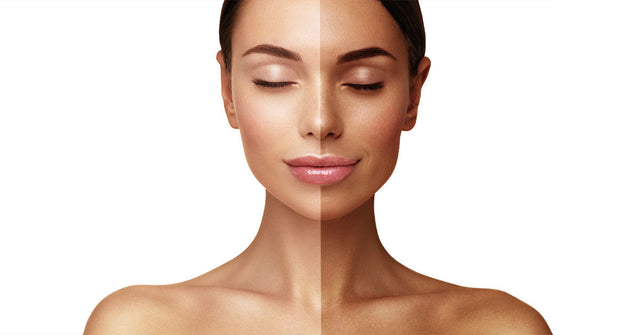Have you ever noticed lumpy, dimpled areas of skin on your arms, belly, thighs, buttocks, or legs? This could be cellulite, which is a skin condition that can be difficult to eliminate. However, there are ways to treat and prevent it.
Cellulite is a very common problem, and it’s mostly a cosmetic issue. It’s caused when fat deposits develop under your skin, but the muscles and fibrous connective cords are also involved in giving your skin this appearance.
Knowing what causes cellulite is a good starting point, as it helps you find methods to reduce it and prevent future development. In this article, we’ll take a closer look at cellulite and answer the question, “Does cellulite go away?”
What is Cellulite and It’s Causes?
Before we dive into what you can do to eliminate cellulite, let’s discuss what it is and what it is not. Many people first notice cellulite after gaining weight. One of the most common questions we get asked is, “Do stretch marks go away when you lose weight?” and some of our readers wonder the same about cellulite.
It’s important to understand that cellulite and cellulitis are two different conditions, although they are often confused. Cellulite refers to fat deposits under the skin, while cellulitis is an infection that requires treatment. However, the focus of our discussion in this article is on cellulite.
So, why do you have cellulite? There are some possible risk factors, one of the more surprising of which is genetics. However, there are other possible causes involved, and as this is a factor out of your control, it’s better not to focus too much on the hereditary link.
It’s important to mention that little is known about the specific root causes of cellulite, except that it is related to fat accumulation. For example, when you gain weight, fat cells collect under your skin and push against the surface, leading to the bumpiness that cellulite is known for.
If you’re a woman, your risk of developing cellulite is highest, and you may be one of our readers who has asked, “Does cellulite go away?” In addition, cellulite is common just after puberty, as well as in older women; age is a risk factor. One study [1] showed that 80-90% of women have experienced some postpubertal cellulite.
Does Cellulite Get Worse With Age?
Yes, aging happens to us all eventually, and getting older does increase your chances of developing cellulite! If you’ve asked yourself, “Does cellulite go away?” then age is an important factor to keep in mind, as the older you are, the more difficult it may be to eliminate.
Having said that, you can start working on preventing future cellulite development when you’re younger by following a consistent skincare routine and living a healthy lifestyle. One of the primary issues as you age is that your skin loses elasticity, and looser skin is more susceptible to developing cellulite.
Does Cellulite Go Away?
One of the most common questions we hear from our readers is, “Does cellulite go away?” The truth is, it depends on the cause of the condition and the steps you take to reduce it. If weight gain is the reason behind your cellulite, then continuing to put on extra pounds won’t solve the problem.
If you’re seeking solutions to decreasing your cellulite, then you’re already on the right track, as following the right approach can improve the appearance of your skin. However, it’s important to note that if the issue is cellulitis rather than cellulite, you will likely require antibiotics.
What Happens Under The Skin When Cellulite Appears?
Cellulite is easy to spot, regardless of where on your body it develops. However, you might be wondering what is happening under the surface, as understanding the physiology can help you eliminate the problem. Cellulite is composed of fat deposits that apply pressure to the surface of your skin, and it’s important to understand that to answer the question, “Does cellulite go away?”
However, it’s not just fat cells that make your skin look lumpy and cause that classic dimpled appearance, as there are also muscle tissue and fibrous connective matter involved in the process. The development of cellulite is complex, with a number of factors involved. However, one certainty is that more fat deposits equal more cellulite.
How to Get Rid of Cellulite?
There are a couple of things you can do to get rid of cellulite. To get rid of cellulite, a combination of lifestyle changes and treatments can help reduce its appearance. Regular exercise, especially strength training and cardio, can improve circulation and tone muscles, making the skin look smoother.
Staying hydrated and maintaining a balanced diet rich in fruits, vegetables, and lean proteins may support skin health and reduce fat accumulation.
Topical creams with caffeine or retinol might temporarily tighten the skin. Massage, dry brushing, and professional treatments like laser therapy or radiofrequency can also improve skin texture. While cellulite is common and harmless, consistent care can help minimize its visibility over time.
So, does cellulite go away? It can, especially when combining multiple strategies. Alongside a high-quality cellulite cream, more intensive options—such as in-clinic treatments like acoustic wave therapy, laser procedures, and radiofrequency—may offer more lasting results. In cases where topical and non-invasive methods are ineffective, surgical intervention could be considered as a last resort.
How to Avoid Cellulite?
What if you could avoid getting cellulite in the first place? That would obviously be helpful as it would prevent you from having to take steps to eliminate it.
If you want a targeted treatment option, Revivatone Neck and Chest Repair Cream can tighten the skin in the neck and chest areas for a smoother contour. Prior to applying the cream, cleanse the skin with Maxatone Clarifying Toner.
Using quality skincare products and changing your lifestyle habits are excellent methods for preventing cellulite from developing or decreasing its appearance. Let’s discuss some of the specific approaches you can take.
1. Exercise Regularly
The average adult is sedentary for about nine and a half hours every day [2]. If you fall into this category and get very little exercise, you could be encouraging the development of cellulite. A sedentary lifestyle could also lead to weight gain, particularly if you don’t follow a healthy diet. As such, our first tip to help you prevent cellulite is to get up and get moving.
Exercise is a great way to prevent weight gain, which decreases your risk of developing cellulite. In addition, physical activity offers other benefits like a healthier heart and mind. Regular exercise is also an excellent complement to a regular skincare routine, as it improves the overall appearance of the complexion and gives you a glow.
2. Follow a Healthy Diet
In addition to improving your level of physical activity, look carefully at your diet. Pay attention to what you eat daily, and if you find it hard to keep track, consider keeping a daily food diary.
Following a healthy diet helps prevent weight gain, and it may also reduce cellulite and decrease your risk of developing it. Eating the right foods also helps support lean muscle mass and can improve your well-being.
3. Stay Hydrated
If you don’t drink enough water daily, you may become dehydrated, and among other problems, this can increase your risk of developing cellulite. Make sure you stay hydrated by drinking at least 8 glasses of water daily. If you’re struggling to drink enough, consider adding more soups and salads to your diet.
4. Exfoliate
While over-scrubbing can be harmful, gentle exfoliating products offer many benefits to skin health. Over time, dead cells can collect on your skin, and your regular body wash and cleansers may not remove them all. That’s where exfoliation comes in. It removes dead skin cells and may also improve circulation, which plays a role in preventing cellulite. We recommend that you exfoliate once or twice weekly as part of your regular skincare routine. It will pay off!
5. Moisturize Regularly
Do you use a moisturizer every day? If not, then it’s time to invest in one. Choose a high-quality product that helps trap the hydration in your skin. The added moisture can plump the skin to smooth the dimples and pocket marks associated with cellulite, as well as boost its overall health.
6. Wear Sunscreen
If you spend a lot of time outside daily, it’s essential to protect your skin from the sun’s harmful rays. Make sure that you apply sunscreen as the last step in your morning skincare routine every day, in every season, or you could develop dryness, irritation, or sunburn. Even if you only go outside now and then, using sunscreen is still beneficial. Apart from sunburn, there’s evidence to indicate that UV rays could also lead to spider veins and cause damage to the skin on a cellular level [3].
Signs Cellulitis is Healing
Remember, we explained that there’s a difference between cellulite and cellulitis? Let’s look at cellulitis in a little more detail. This condition is caused by a bacterial infection, and if you don’t get the right treatment, it can worsen and become a serious problem.
Start by going to the doctor to get a prescription for antibiotics so the condition can heal.
How do you know whether it's healing properly? There are a couple of signs you can look for, as cellulitis usually causes more than just lumpy skin. Redness, inflammation, and other symptoms may be part of cellulitis, and you’ll know it’s healing when these issues begin to subside.
Cellulite - Frequently Asked Questions
Should I Worry About Cellulite?
No, cellulite is not something you should worry about, as it’s very common and is only a problem aesthetically, not medically. Cellulite refers to deposits of fat under your skin that lead to a dimpled appearance. On the other hand, cellulitis can become a serious medical issue, so it’s important to know what it looks like. This condition is an infection in the subcutaneous fat underneath your skin, and it requires immediate medical attention.
Can You Inherit Cellulite?
It might seem unlikely, but yes, you can inherit the tendency to develop cellulite. If women in your close family have it, you have a higher chance of getting cellulite at some point. However, there are other contributing factors that you have more control over, so don’t focus too much on the hereditary aspect.
Can Cellulitis Come Back After Healing?
Yes, it’s possible for cellulitis to come back after successful treatment, depending on what you do after. If you don’t follow a healthy lifestyle by exercising regularly and eating the right foods, you risk having the condition return.
Conclusion
If you have cellulite on your arms, legs, thighs, belly, or anywhere else on your body, you may not like its appearance. If you are concerned about your cellulite, it could negatively impact your self-esteem; however, all hope is not lost.
There are a number of effective ways to decrease and prevent cellulite, including skincare and lifestyle changes. Leaving your cellulite in the dust should help smooth your skin and improve your confidence in your appearance!
References
1] ↑https://pubmed.ncbi.nlm.nih.gov/30809581/
2] ↑https://pubmed.ncbi.nlm.nih.gov/34310489/
3] ↑https://www.verywellhealth.com/effects-of-sun-on-the-skin-1068724
Mentioned in this article
More stories

6 Effective Ways to Reduce the Appearance of Cellulite – Solvadermstore








